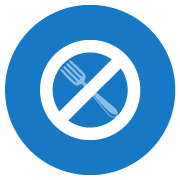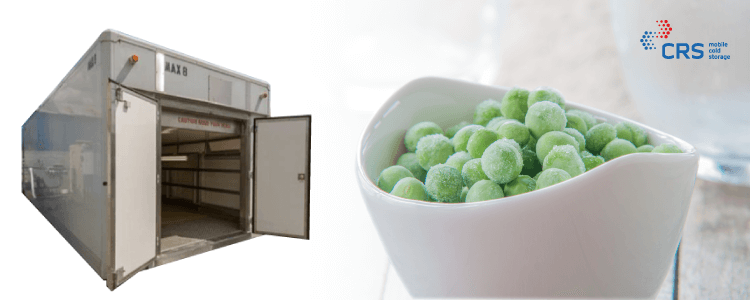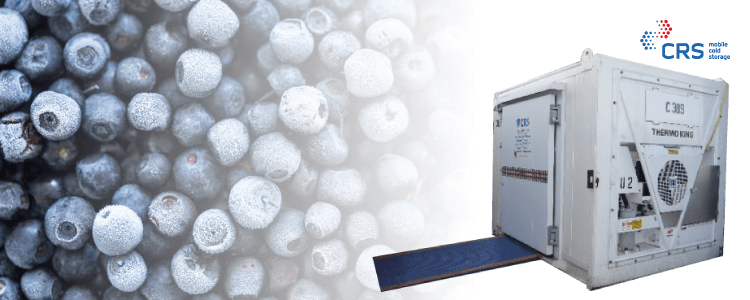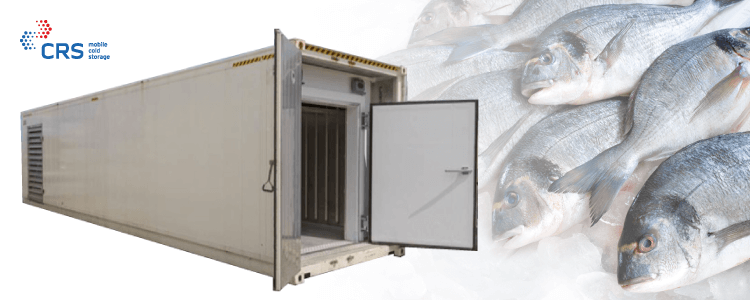Understanding the correct retail cold storage procedures, whether you run a small food outlet, catering business or supermarket, is important if you want produce that is as fresh, delicious and safe as possible. We've put together a handy guide to storing food ready to serve in your retail outlet.
How should different types of produce be stored?

Avoid Cross contamination
It is imperative that cooked and raw products are never stocked near or on top of each other whilst in storage. Even with adequate packaging, the risk of cross-contamination is still there and this should be avoided at all costs.
This is even more significant in refrigerated containers, as produce is stored at a lower temperature and is therefore more prone to leakage and bacterial growth. Alongside this, it’s important to remember that fruits, vegetables and meat products can sometimes have highly different cold store temperatures and should not be packed together in the same unit.

Think about Stock rotation
When storing and unpacking produce, it is imperative that ‘best before’ labels are clearly displayed and that a good stock rotation procedure is followed. This minimises wastage and ensures that that produce with the shortest shelf life is dealt with first.

Avoid Pallet stacking
Regardless of the product, all produce should be stacked in a way that allows adequate circulation of cold air – double stacking should be avoided at all costs. Failure to do this will result in a longer freezing or cooling time and can speed up the growth of bacteria. Tightly packed goods can also reduce the shelf life of foodstuffs, leading to a loss of profit.
The health, safety and security regulations for food cold storage
Cold storage health and safety is important if you want the best for your produce and the best for your team.
Food Storage Best practices
When handling and shipping cold storage produce, there are some best practices that you and your team can follow to ensure your produce is as safe and bacteria free as possible.
- Avoid handling different types of produce in succession (e.g. beef and chicken or pork and vegetables) to minimise the risk of cross contamination.
- Wear gloves when necessary and carry out the correct hand washing techniques after handling produce.
- Keep cold storage units sterile and disinfect containers regularly.
- Check cold store temperatures regularly to ensure produce does not succumb to bacterial growth.
Retail Food Storage Regulation
In retail outlets, regulation states that at least one clearly visible thermometer should be displayed if a cold store smaller than10m3 is used. For those using bigger cold stores and blast freezing units, a monitoring device must be fitted to ensure temperatures stay at the appropriate levels.
On arrival, produce must be checked by a fully trained member of staff to ensure products have remained at a sufficient temperature (around -15°C). If temperature issues are suspected, then goods must be sent back.
How long can food be frozen or refrigerated before reselling?
The storage time of frozen foods can vary depending on the type of product and the temperature at which it is stored. Whilst it’s not possible to offer exact storage times, an average product life can be estimated based on a variety of factors. The minimum legal temperature requirement for most food storage is -18°C, so this is what will be reflected in the chart below.
|
Meat products |
Average storage time at -18°C (approx.) |
Fish Products |
Average storage time at -18°C (approx.) |
Other products |
Average storage time at -18°C (approx.) |
|
Beef |
12 months |
Lean fish |
5 month |
Bakery produce |
10 months |
|
Beef (minced) |
6 Months |
Fatty fish |
6-9 months |
Meat pies |
10 months |
|
Lamb |
12 Months |
Flat fish |
10 months |
Fruit juices |
10 months |
|
Pork |
8 months |
Shellfish |
8 months |
Fruit pies |
12+ months |
|
Veal |
10 Months |
|
|
Dairy |
6 months |
|
Sausage (unflavoured) |
6 months |
|
|
Some fruits and vegetables |
10 months |
|
Chicken |
12 months |
|
|
|
|
|
Turkey |
10 months |
|
|
|
|
Meats with a high percentage of unsaturated fat (sometimes referred to as soft fat), are more prone to rancidity than saturated (hard) fat. This is why many lean meats do not survive as well in cold storage as their saturated fat counterparts.
How can you get the best storage life out of your meat, fish and poultry?
Ultimately, packaging is the most important aspect of keeping meat and fish as fresh as possible. Vacuum packing is one way many distributors are choosing to package and ship their food, as it reduces the amount of oxygen that penetrates the produce.

Fruits and vegetables
Fresh fruit and vegetable storage is a little trickier than meat storage, with storage times and temperatures varying. Below is a list of the most common fruits and vegetables, with their average storage times and temperatures.
|
Fruits and vegetables |
Approx. storage temperature |
Approx. storage times |
|
Apples |
0°C |
2-6 month |
|
Broccoli |
0°C |
10-14 days |
|
Carrots (mature) |
0°C |
4-5 months |
|
Grapes |
0°C |
4-6 weeks |
|
Potatoes (mature) |
3°C |
4-9 months |
|
Tomatoes (ripe) |
7°C |
4-7 days |
|
Garlic |
0°C |
6-7 months |
|
Onions |
0°C |
6-7 months |
The storage life of fruits and vegetables can be greatly extended by ensuring they are well packaged and treated with care. Bumps and bruises will shorten shelf life, as will the length of time in between harvest and cold storage. Alongside this, bad packing practices can cost distributors and retailers thousands of pounds. Take care of your produce and your stock will instantly become more profitable.
Why should I use a portable cold stores?
Convenience
One of the main benefits of cold storage containers is that they don’t require planning permission. This makes them a quick and easy solution for organisations that need extra cold storage right away. Many portable cold stores can be used both indoors and out, making them the perfect solution for retailers and supermarkets alike.
Portable cold stores are great for retailers because they can be moved around with some ease, working as an effective transportation unit between primary and secondary storage centres. Portability is also beneficial if your company is looking to upgrade and move premises in the near future but an expansion is immediately necessary.
Also during months that you need additional storage capacity, you can expand without having to manufacture a physical cold store.

Longevity for food
Portable cold storage is a really efficient way to enhance the life of your products. Whether you’re holding food ready for sale or storing it for distribution, portable units offer a cost effective way to store food stuffs for longer.
When packed and monitored correctly, cold stores can lengthen the life of your products by months with blast freezing and weeks with refrigerated containers. Effective cold stores reduce the amount of food wasted by your organisation, thus saving you money.
CASE STUDY: CRS Provide Cold Store for German Discount Retailer

Customer satisfaction
Fresher food equals happier customers and a portable cold store can help you with this. Foodstuff should be kept in optimum conditions from beginning to end, ensuring that produce is as fresh as possible.
Portable cold storage can be used on-site, during transit and as an easy way to free up space in already overcrowded units. This means there are a number of ways to improve the quality of your products, simply by storing and transporting them in the correct way.
If you’re looking for retail cold storage, take a look at our cold stores specifically designed for use in retail usage.














